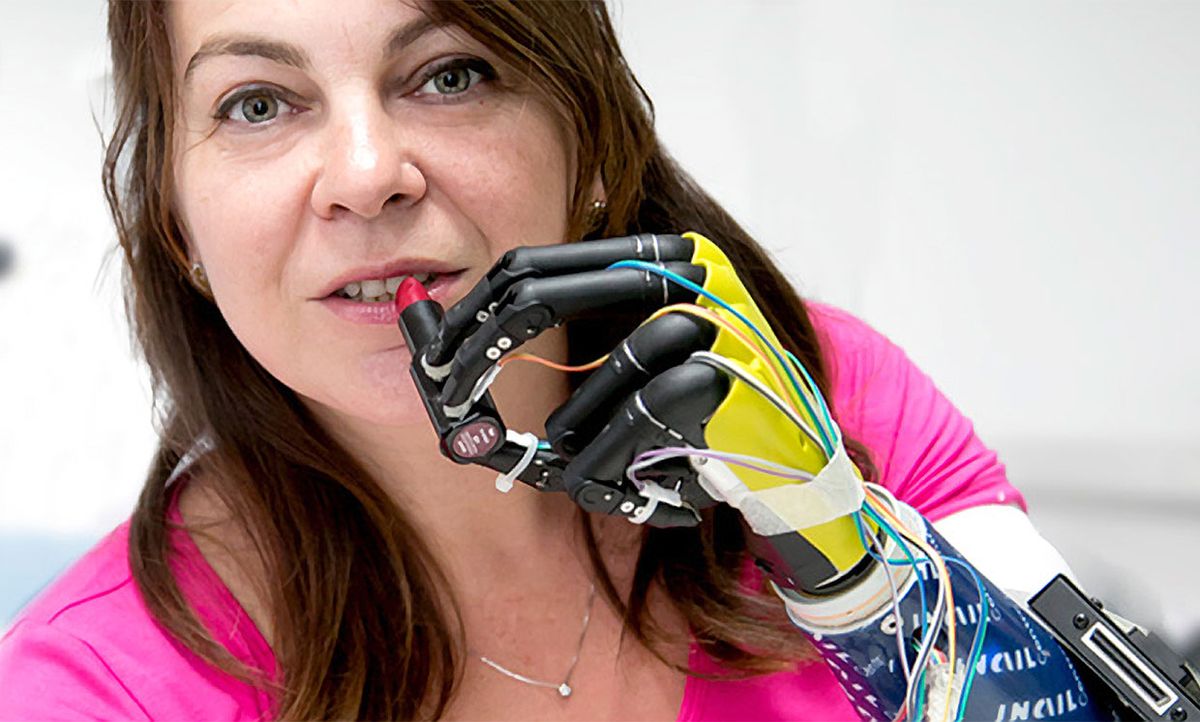If you’re sitting near a coffee mug, pick it up, and note how easy it is to do without really looking. You feel the curvature of the handle, the width of the cup, the slipperiness of the ceramic. Your hand glides into place and you squeeze, getting a sense of the weight, and bring the cup to your mouth.
Now, imagine trying to do that with a robotic hand that gives you no sensory feedback. You get no information about the tiny adjustments that your fingers must make in order to grasp it properly. It feels more like operating a joystick than a hand.
Bioengineers are working to improve that, and this week they made some progress. In a pair of papers published Wednesday in the journal Science Robotics, two research groups, in separate projects, described bionic hands that provide sensory feedback to amputees.
In both papers, researchers implanted electrodes in the stumps of amputees’ arms, on the median and ulnar nerves. They then delivered precise electrical stimulation to those nerves, which send information to the user’s brain about what the bionic hand is doing.
In one report, the bionic hand provided both a sense of touch and a sense of the relative position of the fingers, or proprioception. Two amputees using the robotic hand were able to decipher the difference between four cylinders of various diameters and feel the difference between soft and hard objects. Edoardo D’Anna and Silvestro Micera at the École Polytechnique Fédérale de Lausanne (EPFL) in Switzerland, led the research.
In the other report, the bionic hand provided the sensation of a good grip, enabling the user to sense when an object was slipping from the hand and react to it quickly. Loredana Zollo, Giovanni Di Pino, and Eugenio Guglielmelli, at the Università Campus BioMedico di Roma, in Italy, led the research.
“Sensory feedback is the main way to make a prosthesis a part of the human body,” says Zollo, who coauthored the grip study. About 30 percent of prosthesis users abandon them out of frustration with operating what feels like a foreign body, she says.
Researchers have made progress over the last decade at developing tactile sensors that give users a sense of touch and pressure. But imitating the robust sensory capabilities of the hand remains elusive. Integrating that into a bionic hand that communicates with the body in real time—well, that’s extremely difficult.
Such devices must first extract the user’s intention. This can be done by connecting electrodes to muscles in the forearm or upper arm. An algorithm decodes the electrical signals generated when the amputee makes subtle movements to move his phantom hand, informing the bionic hand of his intention.
Next the brain needs feedback about how things are going. Has the hand made contact? How does it need to adjust to accomplish the task? Did the object move when it was touched? Sensors on the bionic hand pick up that information, and algorithms encode it. That code is converted to electrical stimulation pulses delivered to the nervous system and ultimately to the brain.
Zollo and her colleagues devised a system that can do all of that communication fast enough to enable the brain to sense that an object is slipping from the bionic hand’s grasp, and to correct the hand’s positioning.
To achieve that, the researchers first determined, using healthy volunteers, the signals generated when a grasped object starts to slip through the fingers. They then artificially replicated those signals in a volunteer amputee outfitted with a bionic hand.
Video: Università Campus BioMedico di Roma/Science Robotics/AAAS
In the other report, D’Anna and his colleagues built a system that incorporates not only tactile feedback into a bionic hand but also proprioception—the ability to perceive the relative position and movement of the hand.
Proprioception is far more complicated to generate artificially, compared with tactile feedback, says D’Anna. Movement relative to other movement involves multiple signals from multiple inputs. Plus, the neurons responsible for these signals are usually located close to motor neurons, making it hard to activate them without causing unwanted twitching, he says.
So D’Anna and his colleagues delivered proprioception to amputees by a technique called sensory substitution. Instead of trying to re-create proprioceptive sensations, they trained volunteers to associate proprioception with a separate, easier-to-generate signal.
For example, while grasping a cylinder with a bionic hand, the volunteer felt a separate sensation on her wrist that increases in magnitude as her hand closes. “We substituted touch for proprioception,” says D’Anna.
Video: EPFL/Science Robotics/AAAS
The two new reports add to the growing body of work that provides amputees different kinds of sensory feedback. Last year, a team out of the Cleveland Clinic’s Learner Research Institute used vibration of various tendons in the arm to produce the illusory feeling that specific joints are moving. The technique gives the amputee a sense of his bionic arm moving through space.
But there’s a long a way to go. Spatial awareness, proprioception, grip: As impressive as these advancements are, they represent but a fraction of the range of sensations the human hand can perceive.
Emily Waltz is a features editor at Spectrum covering power and energy. Prior to joining the staff in January 2024, Emily spent 18 years as a freelance journalist covering biotechnology, primarily for the Nature research journals and Spectrum. Her work has also appeared in Scientific American, Discover, Outside, and the New York Times. Emily has a master's degree from Columbia University Graduate School of Journalism and an undergraduate degree from Vanderbilt University. With every word she writes, Emily strives to say something true and useful. She posts on Twitter/X @EmWaltz and her portfolio can be found on her website.



